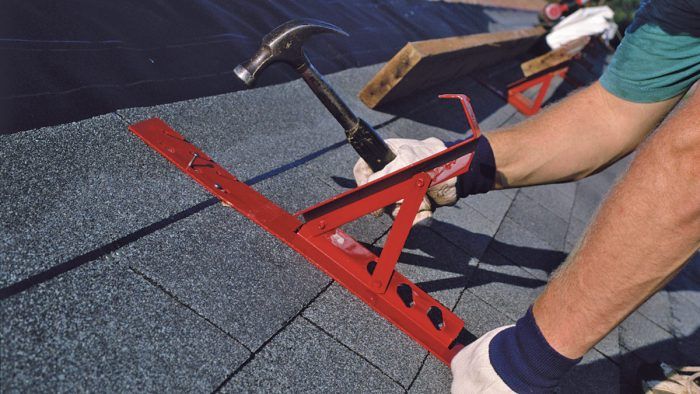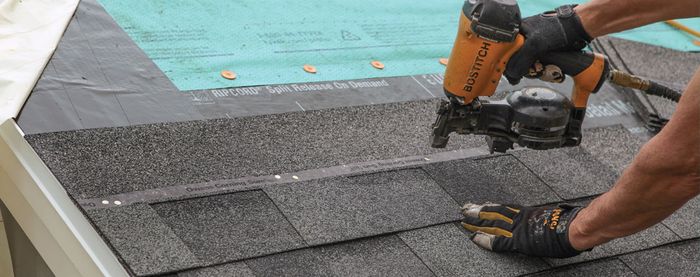Setting Up Roof Jacks
Working from roof brackets and staging planks is the safest and most efficient way to shingle a pitched roof.

Roof jacks provide safe platforms on sloped roofs. They attach to the roof with nails, but don’t use roofing nails; although the heads are broad, roofing nails are short, their shank diameters are small, and their heads pop off easily. Use 10d to 16d common nails and drive them through the roof sheathing and into the framing (see the photo). Don’t rely on nails driven just into the roof sheathing because they’re likely to pull out.
Space the jacks about 6 ft. to 8 ft. apart horizontally. Plan the jack positions so that one falls within 1 ft. of the ends of your staging planks. Also think ahead to avoid placing jacks where the joints between shingles and cutout slots will occur in the course immediately above.
Roof jacks have a long attachment strap with three or four teardrop-shaped holes or diagonal slots to drive nails into. The shape of the holes or slots permits you to remove the jacks later without removing the nails: Just tap the jack upward and the nail heads will be released. To permit the jacks to slide upward during removal, be sure to let them hang low enough when you install them; otherwise the plank support leg will bruise the butt edge of the shingle.
The backs of the triangular-shaped jacks will rest on the exposure portion of the shingle course beneath. With all the motion the jacks will absorb as you walk on the planks set on them, the backs can dig into or scuff the granules on the shingle surface, or worse they can cut through the shingles. For protection, place a piece of scrap shingle between the back of each roof jack and the roof shingle. You can also use pieces of wood-siding shingles as a cushion.
Once you have a row of roof jacks in place and two courses of shingles applied above them, carefully lay staging planks, not dimensional lumber, across the roof jacks. Full-cut 2×8 or 2×10 planks fit roof-jack support arms pretty well. As you lay the planks, be sure you don’t slam them in place because you may pull the nails out of the jacks. Overlap the ends of the planks by 1 ft. to 2 ft., making sure the lap occurs over a roof jack. To hold the planks fast, drive nails through the holes in the turned-up ends of the support arms and into the edges of the staging planks.
| THINKING AHEAD: As you feel yourself getting close to your vertical reach limit when shingling, install a row of roof jacks and apply two more courses of shingles above the jacks. This way you won’t have to bend into an awkward position when you start working on the next level above. You’ll start working 1 ft. above the plank. |
Setting Up Jacks around Shingles
Sometimes you’ll realize that you forgot to install a row of roof jacks and you’ve exceeded your reach limit. You can still install the jacks below shingles that are already installed. Do this by lifting the exposure portion of the shingle where you want a jack, sliding the leg beneath, and carefully driving nails through the holes. It may take an extra set of hands to hold the shingle up while you hold the jack and drive the nails. Be careful not to hit the upturned shingle butt when swinging the hammer.
In cold weather, shingles won’t bend up without cracking. In this case, you may be forced to drive nails through the face of shingles to attach roof jacks. Before doing this, place shingle scrap below the jack-nailing holes to protect the shingle beneath. When you remove the roof jacks, pull the nails and slide a piece of metal flashing coated with roof cement beneath the shingle under the holes. Apply small dabs of cement to each hole on the shingle exposure, then scrape off color granules from a scrap shingle and press them into the cement. This will seal and hide the damage the roof-jack nails caused.
| WORK SMART: Be aware that your toes, tools, and materials stacked on the staging planks can easily bruise the surface of the shingles directly behind the planks. As you walk along the planks, they will flex. Anything touching the shingle surface can abrade it as the planks move up and down. The problem is worse in warm weather when shingles soften. |
Fine Homebuilding Recommended Products
Fine Homebuilding receives a commission for items purchased through links on this site, including Amazon Associates and other affiliate advertising programs.

Affordable IR Camera

8067 All-Weather Flashing Tape

Handy Heat Gun




